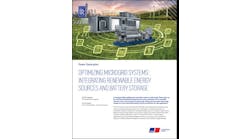Businesses, communities and institutions often wonder how their electric utility will respond if they decide to put in a microgrid. The answer is an aggravating, “It depends.”
Of the more than 3,000 utilities that provide electric power in the US, some embrace microgrids and some don’t. Those that do, use various business models.
Allan Schurr, chief commercial officer at Enchanted Rock, described where utilities tend to fall on the microgrid sentiment scale.
“One, they say, ‘It is not my job to provide behind-the-meter resiliency for my customers. The market can do that. I don’t need to do it,’” Schurr said. “There’s another slice that says, ‘I don’t want to do that because it’s almost like an admission that my grid is not good enough.’ But in reality … no grid can have zero outages.”
Then there is a third — and growing — category that embraces microgrids under various business models. These are “utilities that feel like they should be part of that mix because they can provide a unique value proposition to their customers by participating in behind-the-meter backup power,” Schurr said.
Schurr spoke at Microgrid 2022 on a panel, How to Bring Maximum Microgrid Value to Utilities and Their Customers. He was joined by three utility representatives: Judson Tillinghast, leader of product development and strategy, customer to grid solutions at Arizona Public Service (APS); Alex Rojas, director, innovation implementation and strategy at Ameren; and Tom Bonner, energy policy manager at PECO. The session was moderated by Nathan Johnson, an associate professor at Arizona State University, whose team at the university won the top Microgrid Greater Good Award in 2021 for the ATLAS Containerized Microgrid.
This is the first in a two-part series about what the utilities had to say, beginning with Judson Tillinghast from APS.
Utility and customer partner on microgrid
APS, which serves 1.3 million customers in 11 counties throughout most of Arizona, partners with its customers to help them develop microgrids. The customers make a one-time upfront payment, and the utility maintains and operates the microgrid under a contract of up to 30 years.
Share your opinion on utilities and microgrids. Take the Microgrid Knowledge Utility Survey.
A 25-MW microgrid at Marine Corps Air Station in Yuma serves as one of its most notable projects. Because of improved power quality from the microgrid, the air station is experiencing better flight and fight simulator uptime, Tillinghast said.
The utility has partnered with customers on about 200 MW of microgrids, sharing in both the cost and value. In many cases the customers had been operating Tier 2 diesel generators for backup, and the utility helped them upgrade to Tier 4 generators, which are cleaner burning.
Microgrid ‘brain’ in action
The microgrids export power to the grid when APS needs it, provided they are not in use by the customer.
“The microgrid [controller], the brain itself, can sense frequency deviations in the grid in an autonomous fashion, turn the gensets on parallel to the grid, all in roughly 10 seconds or less, and start exporting power, which improves the power quality for the customer and essentially the entire grid,” Tillinghast said.
“This has happened on numerous occasions. Before our ECC [energy control center] can usually even find out that we have an issue, that microgrid is already paralleled to the grid and exporting. And the microgrid, itself, will recognize when the grid is back … and it will shut itself down,” he added.
The microgrids also keep the grid stable by offering spinning reserve when a power plant trips, ramping up quickly to offset any loss. In doing so, they avert the need to keep natural gas plants constantly running for that purpose.
Less expensive, cleaner, more reliable
The bottom line, Tillinghast said, is that the microgrids reduce carbon, nitrogen oxide and other emissions, improve electric reliability and lower customer costs.
The utility continues to add microgrid customers and is currently working on a 6.5-MW microgrid for a water treatment facility in Phoenix.
“It’s something we look forward to doing more,” he said.
Watch the full video here free of charge.







